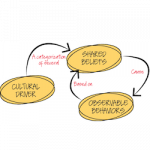If you’ve been employed for more than about fifteen years, you have probably observed the same change we’ve seen in attitudes toward lunch. Before this time, lunch with workmates was so common that it was essentially a norm. And since? Since then companies have bifurcated, some making a huge fuss over the value of lunch with co-workers, while others have seen the phenomenon almost disappear.
First the fuss-makers: You don’t have to work for a high-flier company to become aware that some of them have elaborate cafeterias, multiple serving stations with different menu options: Chinese, Thai, barbecue, made-to-order sandwich and burger stations, carveries and elaborate desserts. Some have free food and optional table service, outdoor lunch spots, and espresso bars. Do an internet search for “best companies for lunch” to see some mouth-watering possibilities, and not just in Silicon Valley. The message these companies are sending is that lunch with your colleagues is clearly something to be encouraged, that it’s completely consistent with the organizations’ goals.
The other side of the coin is organizations where lunch is most times taken alone at a desk. The cover story for this varies, but the end result is the same. Sometimes people say they are too busy to take a lunch break; sometimes people feel guilty if they take a lunch break and their colleagues don’t; some people feel that doing menial tasks while eating lunch at their desks is the same as taking a break.
Whatever the thinking, the result is people eat at their desks and keep on working. This despite laws in most countries that mandate that employees take a break, and despite most managers understanding the benefit of employees taking a break with their colleagues. And yet they don’t, even in organizations that aren’t busy at all.
The unspoken rule in these companies is:

Lunch with colleagues is a luxury to be indulged in only when time permits (and time never permits).
What’s saddest about this is that lunch with colleagues is a culture-building experience. It’s over lunch that you learn that Arlene’s son has just won a scholarship, that Larry has a quirky sense of humor, or that others (not just you) are uneasy about the coming expansion plan. If there’s a difficult relationship with a peer organization, you learn who the players are and how to deal with each one. None of this happens in a lunchless culture. Whatever the willingness to trust was before lunch it may be higher after. Teams that take lunch together are much more likely to be trusting and familial.
To end on an optimistic note: the trend toward lunchlessness has been successfully resisted in both France and Italy.


 A culture killer is what ruins workplace culture in spite of your every effort. When we were researching our new book,
A culture killer is what ruins workplace culture in spite of your every effort. When we were researching our new book,  Tom DeMarco’s speculative novel,
Tom DeMarco’s speculative novel, 
 How workplace culture affects workplace performance: We know they’re linked, but now we know a bit more about how and why:
How workplace culture affects workplace performance: We know they’re linked, but now we know a bit more about how and why: 

 Two coauthors reflect on some of the unexpected implications that a reader may detect in what they’ve written.
Two coauthors reflect on some of the unexpected implications that a reader may detect in what they’ve written. 






